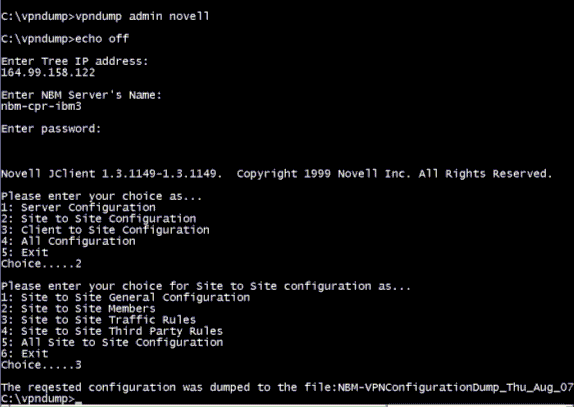VPN Configuration Dump Tool
The VPN Configuration dump tool is a command line utility that dumps the required VPN configuration information to a file. The VPN configuration is read from Novell eDirectory and written to a text file on the server.
The user is provided with menus indicating which specific type of dump can be chosen.
Information That Can Be Dumped
The following VPN Configuration information can be dumped into a file.
VPN Server Information: This includes information about services being hosted on the server.
VPN Client-to-Site Configuration: This includes general configuration and traffic and authentication rules. The general parameters include remote LDAP server information and DNS/SLP configuration.
VPN Site-to-Site Configuration: This includes general configuration. member details and traffic and third-party rules.
Viewing the Dump Information
The dump tool can be used on NetWare® as well as on Windows.
On NetWare
The files for the dump tool on Netware are vpndump.ncf and vpnDump.jar. These two files are available as a zip file named vpndump_NW.zip in the unsupported directory under VPN on the product CD.
The vpndump_NW.zip file must be unzipped on the sys: volume of the NetWare server. The following files will be copied in the specified folders:
- vpnDump.jar in sys:\tomcat\4\webapps\nps\web-inf\lib
- vpndump.ncf in sys:\system
Run Tomcat 4 and restart Tomcat.
To use the tool:
On Windows
The files for the dump tool on Windows are vpndump.bat, vpnDump.jar and vpndump_win_readme.txt. These three files are available as a zip file named vpndump_win.zip in the unsupported directory under VPN on the product CD.
The vpndump_win.zip file must be unzipped under any folder in a Windows machine.
After extracting the three files into a folder:
-
Edit the vpndump.bat file. To do so, change the SET UDR=C: \ imgrsdk\tomcat line to provide the tomcat_home path.
The tomcat home path is the folder where tomcat has been installed. SET UDR= < tomcat_home absolute path >
-
Save the vpndump.bat file. Run the vpndump.bat file by providing two arguments, user and context.
vpndump <user> <context>
For example, vpndump admin novell
-
You will be prompted for the Tree IP, Novell BorderManager server name, and the password. After successful authentication to the server, you can choose the type of dump.
The configuration will be dumped to a text file and the name of the text file will be displayed.
